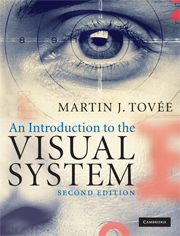Book contents
- Frontmatter
- Contents
- 1 Introduction
- 2 The eye and forming the image
- 3 Retinal colour vision
- 4 The organisation of the visual system
- 5 Primary visual cortex
- 6 Visual development: an activity-dependent process
- 7 Colour constancy
- 8 Object perception and recognition
- 9 Face recognition and interpretation
- 10 Motion perception
- 11 Brain and space
- 12 What is perception?
- References
- Index
- Plate sections
12 - What is perception?
Published online by Cambridge University Press: 05 June 2012
- Frontmatter
- Contents
- 1 Introduction
- 2 The eye and forming the image
- 3 Retinal colour vision
- 4 The organisation of the visual system
- 5 Primary visual cortex
- 6 Visual development: an activity-dependent process
- 7 Colour constancy
- 8 Object perception and recognition
- 9 Face recognition and interpretation
- 10 Motion perception
- 11 Brain and space
- 12 What is perception?
- References
- Index
- Plate sections
Summary
Putting it all together
As we have seen in previous chapters, visual information is broken down into its components and processed, in parallel, in specialised areas, so that cells in different areas show a preference for different combinations of, for example, colour, motion, orientation, texture, shape and depth. This is all carried out in a complex network of 32 visual areas connected by at least 305 connections (Van Essen, Anderson & Felleman, 1992). These connections can run in three ‘directions’. Firstly, from lower areas (such as V1) to higher areas (such as V2). These are called feed-forward connections. Secondly, all these feed-forward connections have reciprocal feedback connections running from higher to lower areas. Thirdly, there are also lateral connections running from areas of equivalent processing complexity. In addition to these problems, there are the differences in how fast different visual parameters are processed (Zeki, 2003). For example, location is perceived before colour, and colour is perceived before motion and orientation (Zeki & Moutoussis, 1997; Pisella et al., 1998). It seems a far from trivial task to re-integrate all of this information from this complex spatial and temporal network into the seamless, coherent perception of the world we all share.
There are two obvious problems. Firstly, we have to put all the different visual features of an object back together in the right spatial and temporal relationship to one another.
- Type
- Chapter
- Information
- An Introduction to the Visual System , pp. 175 - 186Publisher: Cambridge University PressPrint publication year: 2008



